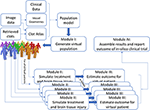I totally disagree, you see a doctor immediately and get anti-coagulation going. You don't wait until it gets severe before you see a doctor. I'm going to demand heparin.
Heparin binds to cells at a site adjacent to ACE2, the portal for SARS-CoV-2 infection, and "potently" blocks the virus, which could open up therapy options.
Anticoagulation Again Shown to Improve Survival in COVID-19 Patients;-Mortality risk about 50% lower
Stroke occurs frequently in COVID-19, leads to ‘devastating consequences’ for patients
I'm not medically trained so I know nothing, don't listen to me.
The latest here:
What to do if you test positive for COVID-19
You've gotten tested for COVID-19. What happens if it comes back positive?
Typically, a nurse or another health care professional will call to give you the news. Then they'll walk you through everything you need to know to keep you and those around you safe.
"We know that if someone tests positive, they have a lot of questions, and we want to make sure they have all their questions answered," said Linda Barman, MD, associate director of Stanford Medicine's CROWN Clinic, which was launched in April to care for COVID-19 patients who don't need hospitalization.
Barman provided these tips for weathering COVID-19.
How to quarantine
Each situation is unique and depends on who lives in the house and how vulnerable they are. When an entire family has tested positive at the same time-- which is not uncommon -- they can self-quarantine together.
If just one member of a family is infected, it's important to discuss the situation with a health care provider, who can make recommendations to keep the whole family safe. Sometimes positive patients will stay in a hotel while they are contagious. Other times, a positive patient can self-quarantine in a bedroom and connected bathroom. If that isn't possible, all members of the household should wear masks at all times in shared spaces. With a shared bathroom, everyone should wipe down every surface with disinfectant wipes after every use
Also, since the coronavirus has been detected in stool, "Close the lid on the toilet before flushing," said Barman, who is a clinical assistant professor of medicine and the associate director of Stanford's Express Care Clinics.
Who should prepare food
Infected people should avoid preparing food, if possible. If they must cook, they should prepare food only for themselves and thoroughly wipe down kitchen surfaces afterward.
When to contact a clinician(Wrong, wrong,wrong. See a doctor immediately)
Typically, COVID-19 is at its worst around 8 to 10 days after symptoms start. Patients should call a doctor or another clinician if their breathing gets more difficult or if they experience chest pain, Barman said.
They also should look out for what Barman calls the "shower sign" -- feeling so tired, they can't muster the strength to shower.
"That's happened so many times with people who ended up getting really sick," she said. "So, if you're so tired you can't take a shower, I need to see you in person."
How to monitor your oxygen level at home
COVID-19 often negatively impacts how well oxygen is transferred into the bloodstream, but a patient doesn't always feel short of breath when their oxygen levels are low. Patients at home can monitor the percentage of oxygen in their blood using a pulse oximeter, a relatively inexpensive device that comfortably clamps onto a finger. Products that are "FDA-approved for home medical use" are best, Barman said.
A reading of 97% or higher is considered healthy, she said. If a patient has a reading of 96% or lower, they should contact a clinician; that may signal that their lungs are not functioning well.
When taking a reading, she said, it can take 30 to 60 seconds to come to a steady reading. The monitors may pick up a signal better on one finger than another -- if it is reading less than 96%, patients should try it on another finger. The highest pulse oximeter number is the correct one -- it could read artificially low, but not artificially high. Many pulse oximeters also record a heart rate or pulse. The instructions should indicate which is which.
How to stay comfortable
To ease breathing, Barman suggested sleeping and lying on the stomach, called proning. She recommended acetaminophen for fever or aches. If possible, patients should get up and move around once an hour, as lying in bed for long periods can cause back pain and stiffness.
How to speed healing
For exercise and vitamin D from sunshine, Barman urged COVID-19 patients to get outside once a day for as little as 15 minutes -- but only if the air quality is good and they can do it safely without going into public spaces. It is also important to stay well-hydrated.
When to end quarantine
Patients who are generally healthy and have mild symptoms should follow the 10-3 Rule, Barman said: self-quarantine for 10 days after symptoms begin and for at least three days following the onset of a fever.
People who are immunosuppressed or are admitted to the hospital should isolate for 20 days following the onset of symptoms, she said. After ending self-isolation, patients should continue to wear masks when out in public and wash hands frequently, Barman said.



 Praneeta R. Konduri
Praneeta R. Konduri Henk A. Marquering
Henk A. Marquering Ed E. van Bavel
Ed E. van Bavel Alfons Hoekstra
Alfons Hoekstra Charles B. L. M. Majoie
Charles B. L. M. Majoie